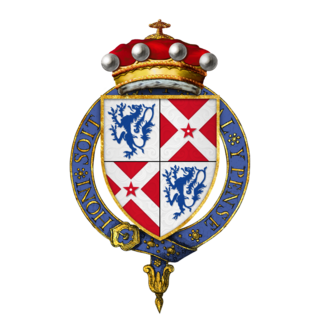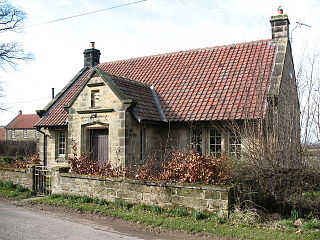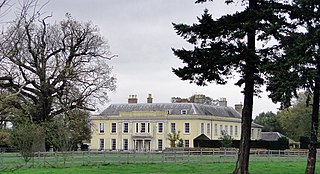
Rise Hall (formerly Rise Manor, or Rise Park) is a Grade II* listed stately home in Rise, East Riding of Yorkshire, England. [1]

Rise Hall (formerly Rise Manor, or Rise Park) is a Grade II* listed stately home in Rise, East Riding of Yorkshire, England. [1]

Rise is recorded in the Domesday Book of 1086 as having been owned by Cnut (the son of Karli) in 1066. The estate at this time comprised 6 carucates of ploughed fields, a value roughly equal to 720 acres (2.9 km2 ; 1.13 sq mi ). It also had 30 acres (0.12 km2; 0.047 sq mi) of meadow and 40 acres (0.16 km2; 0.063 sq mi) of woodland. [2]
For some time between 1066 and 1071, the estate belonged to William Malet before coming into the possession of Drew de Bevrère [3] (rendered in some sources as Drogo of la Beuvriëre [2] ).
Rise Manor was tenanted by Franco de Fauconberg, and the Fauconbergs retained ownership until 1372 when the estate was sold to Sir John Neville by Sir Thomas Fauconberg. The estate remained in the Neville family passing down to Richard Neville, 16th Earl of Warwick, whose lands (including Rise) were seized by the crown after his death in 1471. [3]
The estate next passed into ownership of Richard Neville's son-in-law Richard Plantagenet, Duke of Gloucester who later became Richard III of England. The estate remained a crown estate until 1628 when the house and 120 acres (0.49 km2; 0.19 sq mi) of woodland were used as security for a loan from the city of London to the crown. In 1639 the grantees of the loan sold the estate to a William Raven and a Michael Evans. However they did not retain ownership long as they sold freehold in 1646 to a Thomas Bacon and Christopher Beckwith, who were buying on behalf of Hugh Bethell. At the same time as this transaction took place, Bethell himself bought out an existing leasehold on the estate. [3] Evidence of this phase of construction was found in 2011 during restoration, when several Jacobean wood panels were discovered in what had been the estate office.

The Hall was rebuilt by Richard Bethell between 1815–20. An English Heritage report into buildings of special architectural or historic interest in Yorkshire suggested that Robert Abraham, a relation of the family, may have been the architect hired to carry out the renovation. [4] However the Pevsner architectural guide to the Buildings of England suggests that Watson & Pritchett of York could be the architects. [5] The house is primarily west facing, where it is fronted by a Grecian-style portico supported by pillars. The house also has north and south aspects fronted identically with a slight wing of 6 feet (1.8 m ) at either end and a pediment over the central doorway. [6] Before the purchase of the manor, the Bethell family had been buying many surrounding farms and properties, [3] so that by 1856 the estate constituted 130 acres (0.53 km2; 0.20 sq mi) land set aside for around 300 deer to roam in, 120 acres (0.49 km2; 0.19 sq mi) of woodland, and 20 acres (0.081 km2; 0.031 sq mi) of fish ponds. [6] In 1995, the majority of the village of Rise was still owned by the Bethell family. [3]
It was around this time that a clock was installed over the stable block, constructed by the clockmaker Edward John Dent, the man behind the clock movement in Big Ben in the Palace of Westminster, this was rediscovered during renovations in 2011.
By 1884 the estate contained at least one cricket pitch, because in that year it played host to what is now considered an unusual match in that the opposing team was made up of 11 brothers – the Walgates of Aldbrough. The Walgates won the match by 3 wickets. [7]
During the Second World War the manor served as headquarters for the operation of searchlight batteries in the local area, and accommodated the officers manning them. This is recorded by graffiti on walls inside the building that gives details of the officers stationed there. The estate also hosted a motor transport depot, positioned in a structure outside the main building. [8] At the start of the war the whole herd of deer on the estate was killed and the park was ploughed for agricultural use; it is only since that time that the estate has been allowed to return to grass. [3]
From 1946 until 1989, the building was used as a convent school dedicated to St. Philomena, and served as host to an order of nuns, the Canonesses Regular of St. Augustine. The school had both boarding and day students. Around 1980, the school added an extension to the east of the house, aligned with the south face, containing a gymnasium and a dining room. The order continued to use the house until 1995 to run religious retreats, holidays, weekend courses and meetings. [3]
The Hall stables and coach house are all listed buildings. [9]
The Hall had fallen into disrepair before being bought in March 2001 by TV host and property expert Sarah Beeny and her husband, artist Graham Swift. The couple paid £435,000 (equivalent to £706,646 in 2018) for the property, and began restoration work on it. [10]
Initially the couple worked on making the property watertight, by renovating the roof and guttering. The gutters had been the source of substantial problems, overflowing into the house and causing outbreaks of both wet and dry rot. To solve the problems, a lot of timber had to be replaced. The couple also had to remove many of the fixtures that existed only to serve the former convent school, such as lavatory and shower cubicles, and hardboard walls. [11]
In November 2010, Beeny presented Beeny's Restoration Nightmare on Channel Four, [12] showing her plans for the renovation of Rise Hall as a family home and wedding venue. [13]
After the airing of the first series, the local council became aware of the renovation work, and raised objections that the work did not comply with planning regulations and listed building consent had not been obtained. That forced the couple to apply for retrospective planning permission and listed building consent, and make fire safety improvements. [14] They also had to spend £12,000 applying to obtain a certificate of lawful development which recognised that the property was primarily being used as a domestic dwelling. [14]
In carrying out the renovation, Beeny and Swift stated that they intended to restore, maintain and guarantee the survival of the property, ensuring it is protected as part of British heritage, and would create financial and employment growth through the use of contractors and materials required for its restoration. [15] During the second series, the couple gave art students from Hull College the opportunity to gain experience by assisting in the design and construction of the family room. [16]
In April 2019, Beeny and Swift sold Rise Hall to Daniel and Helen Gill, owners of an events and weddings business. Rise Hall continues to operate as a weddings and events venue. [17]

The National Trust is a charity and membership organisation for heritage conservation in England, Wales and Northern Ireland. In Scotland, there is the separate and independent National Trust for Scotland.

The Duchy of Lancaster is a private estate of the British sovereign. The estate has its origins in the lands held by the medieval Dukes of Lancaster, which came under the direct control of the monarch when Henry Bolingbroke, the then duke of Lancaster, ascended the throne in 1399. In 1461 King Edward IV confirmed that the Duchy would be inherited by the monarch, but held separately from the Crown Estate, the other assets which belong to the monarch.

Coxwold is a village and civil parish in the Hambleton District of North Yorkshire, England, in the North York Moors National Park. It is 18 miles north of York and is where the Rev. Laurence Sterne wrote A Sentimental Journey.

Doughoregan Manor is a plantation house and estate located on Manor Lane west of Ellicott City, Maryland, United States. Established in the early 18th century as the seat of Maryland's prominent Carroll family, it was home to Founding Father Charles Carroll, a signer of the United States Declaration of Independence, during the late 18th century. A portion of the estate, including the main house, was designated a National Historic Landmark on November 11, 1971. It remains in the Carroll family and is not open to the public.

Sewerby Hall is a Grade I listed Georgian country house set in 50 acres (20 ha) of landscaped gardens in the village of Sewerby, 2 miles (3.2 km) from the seaside town of Bridlington in the East Riding of Yorkshire, England.

William Neville, Earl of Kent KG and jure uxoris 6th Baron Fauconberg, was an English nobleman and soldier. He fought during the latter part of the Hundred Years' War, and during the English dynastic Wars of the Roses.

The Fauconberg Arms is a 17th-century Coaching inn in Coxwold, North Yorkshire, England. The village and estate were given to the Fauconberg family by Henry VIII. The property is still owned by the Newburgh Priory Estate and is named after the Earl of Fauconberg. It serves beer and a selection of food and is close to Shandy Hall and the Kilburn White Horse.
Sarah Lucinda Beeny is an English broadcaster and entrepreneur, best known for presenting Property Ladder (2001–2009), Britain's Best Home (2003), Streets Ahead (2005–2006), Property Snakes and Ladders (2009), How to Live Mortgage Free with Sarah Beeny (2017), Sarah Beeny's New Life in the Country (2020–present) and Sarah Beeny's New Country Lives (2023).
Robert Abraham (1773–1850) was an English building surveyor and later architect in London. He was the son of a builder and was educated as a surveyor as a pupil of James Bowen. He turned to architecture after 1818, and was chiefly employed by the leading Roman Catholic families in England, including the Duke of Norfolk and the Earl of Shrewsbury.

Cowesby is a village and civil parish in the Hambleton District of North Yorkshire, England. Part of the village including The Cowesby Hall Estate is within the North York Moors National Park and about 7 miles (11 km) north of Thirsk. The population of the civil parish was estimated at 70 in 2014.

Thimbleby is a small village and civil parish in the Hambleton District of North Yorkshire, England, it is in the North Yorks Moors and close to the village of Osmotherley and the Cleveland Way, 6 miles (9.7 km) east of Northallerton. The population of the civil parish as of the 2011 census was 258.

Rise is a village and civil parish in Holderness, the East Riding of Yorkshire, England. It is situated approximately 7 miles (11 km) east of the town of Beverley and 5 miles (8 km) south-west of Hornsea. It lies to the east of the B1243 road.

Markenfield Hall is an early 14th-century moated manor house about 3 miles (5 km) south of Ripon, North Yorkshire, England. It is in the civil parish of Markenfield Hall.

Newburgh Priory is a Grade 1 listed Tudor building near Coxwold, North Yorkshire, England.

Little Cressingham lies 2.5 miles (4.0 km) south east by road from Great Cressingham, 3 miles (4.8 km) west of Watton and 8 miles (13 km) south of Swaffham in the Breckland District of Norfolk. It covers an area of 11.90 km2 (4.59 sq mi) and had a population of 157 in 70 households at the 2001 census It is in the civil parish of Great Cressingham. The village is located on the edge of the Stanford Battle Area.

The Artizans, Labourers & General Dwellings Company was a nineteenth-century philanthropic model dwellings company, which later became a multinational property developer before being absorbed into Sun Life.
Restoration Home is a BBC television series produced by Endemol who created the BBC series Restoration. The series follows owners of historic buildings as they restore them into 21st-century dream houses. The show is presented by Caroline Quentin who has an interest in the history and restoration of old buildings, architectural expert Kieran Long and social historian Dr Kate Williams who investigate the histories of the properties.

Damhouse or Astley Hall is a Grade II* Listed building in Astley, Greater Manchester, England. It has served as a manor house, sanatorium, and, since restoration in 2000, houses offices, a clinic, nursery and tearooms.

Worlingham Hall is a Grade I listed Georgian country house in Worlingham, 1 mile (1.6 km) to the east of Beccles in the English county of Suffolk. The hall was built in the 18th century, possibly based on an earlier 17th century house, and as of 2014 is a country house hotel.
Sarah Beeny's New Life in the Country is a British television series, first shown in 2020, which showed property developer Sarah Beeny and her family's move to Somerset from London, including building their dream home and adapting to country life.
![]() Media related to Rise Hall at Wikimedia Commons
Media related to Rise Hall at Wikimedia Commons